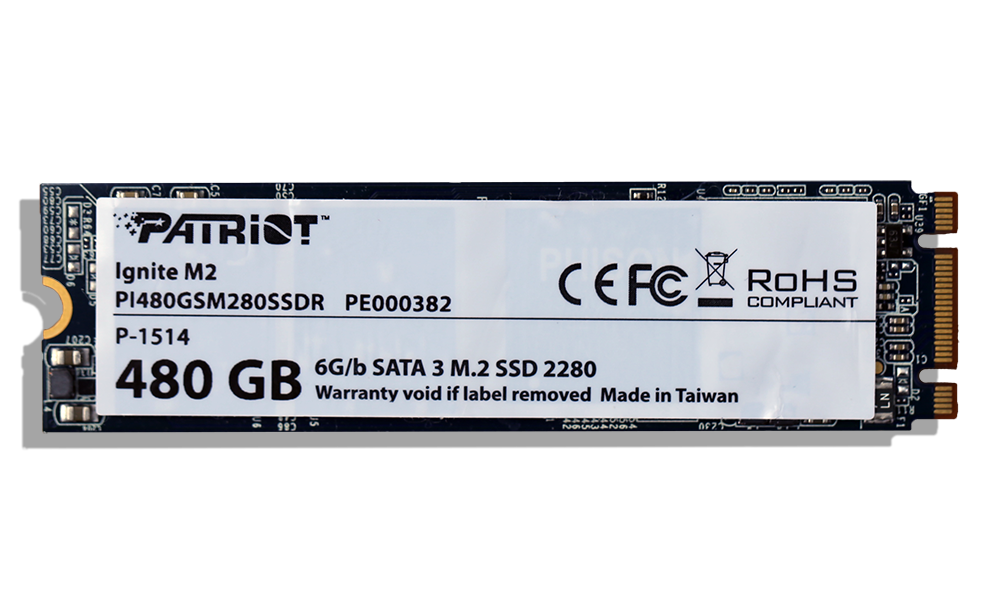It is said that 2015 will be the year of the M.2 SSD form factor and, by all indications, this assumption seems to be correct. This is a very big plus for the SSD industry, as well as a very clear demonstration of the progress we have made in flash technology within the last few years. For instance, our Patriot M.2 sample that we are reviewing today weighs less than 10 grams, takes up virtually no space in new motherboards, yet has a capacity of 480GB and can transfer data at over 500MB/s with very little heat…and absolutely no noise. In other words, a storage device smaller than a stick of gum can hold roughly 8500 hours of music, 500 hrs of video, or 155,000 photographs.
The Patriot Ignite M.2 SSD is a SATA 3 (6GBps) M.2 SSD, available in capacities of 240 and 480GB, has end-to-end data protection, is TRIM compliant and has a three-year warranty. The Ignite is of a 2280 (80mm) M.2 form factor which means it is 80mm in length; other M.2 form factors including 30, 42, and 110mm. Performance for the Ignite M.2 SSD is listed as 560MB/s read and 320MB/s write with up to 90K IOPS at low 4k random write disk access. One might notice that the write performance is a bit low, a factor attributed to the memory which just so happens to be asynchronous.
Something very encouraging about this SSD is its price with Amazon prices![]() displaying the 240GB at $130 and the $480GB at $242 at the time of this report.
displaying the 240GB at $130 and the $480GB at $242 at the time of this report.
COMPONENTS
The Patriot Ignite M.2 480GB SSD is situated on a green M.2 PCP with a Phison Quad-core PS3110-S10 SATA3 controller under its branding sticker. This controller is by no means new in nature and we have seen it in Kingston Hyperx Savage and Corsair Neutron XT SSDs reviewed here at TSSDR within the last year.
Located on both sides of the SSD are four pieces of branded memory that Patriot identifies as Micron 16nm asycnchronous MLC NAND flash memory, each package being 128GB in RAW capacity.
Last but not least, there is a NANYA 512MB DRAM cache chip on the rear of the PCB, this chip being 240MB in the case of the 240GB SSD.
The capacity of the SSD is listed as 480GB, identifying that 7% overprovisioning has been set in this SSD, reducing it from the original RAW capacity of 512GB. Once formatted, the available user capacity for storage is 447GB.
 The SSD Review The Worlds Dedicated SSD Education and Review Resource |
The SSD Review The Worlds Dedicated SSD Education and Review Resource | 


LES, from what I’ve gathered the M.2 SSD’s overheat a lot, as compared to traditional 2.5 inch or PCIe (slot) drives, & as a result throttle from time to time. Is that more like a norm now or are there exceptions, talking particularly about drives that are close to the SM951 in terms of performance, especially considering there’s very little data on this topic of temperature &/or thermal throttling of M.2 drives from reputable sites like yours?
Can I ask where you are hearing this info on overheating? We have yet to have any drives overheat or throttle in testing. We like to think the 17-24 testing where The drive is filled and TRIM is constrained for several hours might cause such…but it hasn’t. We run several M.2 drives on a continual basis in our systems without any heat considerations at all.
The difference between most PCIe and the notebook drives is they require a mechanism to get the heat to the exterior of the package to dissipate, whereas, the M.2 does not. Imagine running a race car without a hood.
Mostly on forums like AT, TPU, Toms et al. This is just for desktops btw, & most of’em were overclocked setups, so anecdotal or hearsay at best.
I’d like to think in a non open bench system this would be more of a problem, since I don’t own any M.2 SSD myself I’ll just have to rely on word of mouth from fellow board members but there certainly have been complaints of overheating from many of them. As for thermal throttling IIRC only the latest models, like 850 EVO & some of the others, have this mechanism incorporated that actually throttles the drive under severe conditions viz high temperature.
So to sum it up I’m just curious to know whether the extremely SFF & controller are responsible for this overheating/throttling phenomena or are the drives absorbing excess heat from the mobo &/or the CPU, GPU with the results varying greatly, depending on the individuals’ setup also their case airflow?
HELLO , looking for this form SSD with more than 500 GB any words awhere to get those
Many people are – they do not exist (yet). My guess is that first designs are around six month away. Samsung said that they intend to make higher capacities (no details, just vague between the lines suggestion). BTW, Les was asked this a few times, but never commented, thus he also does not know who/when, etc.